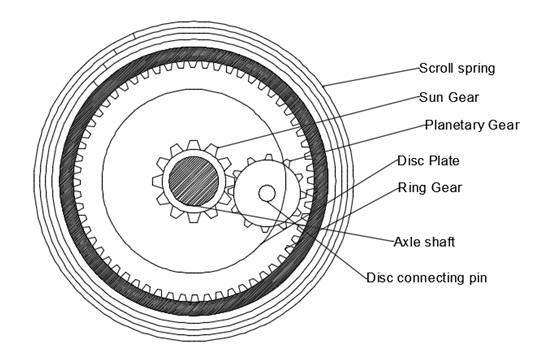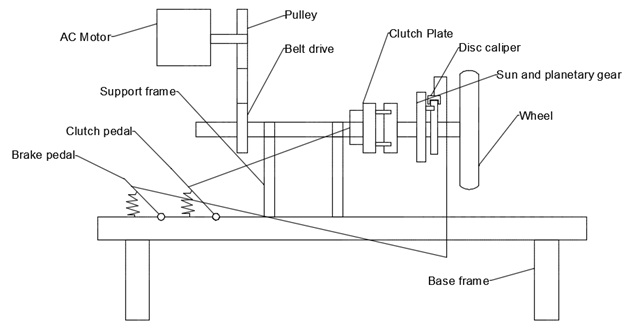





Published on Sep 03, 2023
Presently what the world needs is a method or a technology that saves energy from getting wasted. Energy conservation is the hour of need. In case of automobiles, energy conservation can be done by using regenerative braking systems (RBS). When driving an automobile, a great amount of kinetic energy is wasted when brakes are applied, which then makes the start up fairly energy consuming. The main aim of this project was to develop a product that stores the energy which is normally lost during braking, and reuses it.
The use of regenerative braking system in automobiles provides us the means to balance the kinetic energy of the vehicle to some extent which is lost during the process of braking. The authors of the paper have discussed and presented two methods of using the kinetic energy which generally gets wasted by converting it into either mechanical energy or into kinetic energy. Scroll roll spring is used for converting the kinetic energy to mechanical energy.
The term ‘Braking’ in a moving vehicle means the application of the brakes to reduce its speed or stop its movement, usually by depressing a pedal. The braking distance is the distance between the time the brakes are applied and the time the vehicle comes to a complete stop.
In braking systems on conventional vehicles, friction is used to counteract the forward momentum of a moving vehicle. As the brake pads rub against the wheels or a disc that is connected to the axles, excessive heat energy is created. This heat energy dissipates into the air, wasting as much as 30 percent of the vehicle's generated power. Over time, this cycle of friction and wasted heat energy reduces the vehicle's fuel efficiency. More energy from the engine is required to replace the energy that was lost by braking.
Every time we step on our car's brakes, we are actually wasting energy. As we know that energy can neither be created nor be destroyed. It can be just converted from one form to another. So when our car slows down, the kinetic energy that was propelling it in the forward direction has to go somewhere. Most of it simply gets released in the form of heat and becomes useless. That energy, which could have been used to do work, is essentially wasted. The solution for this kind of this problem is Regenerative Braking System.
This is a new type of braking system that can recollect much of the car's kinetic energy and convert it into electrical energy or mechanical energy. Regenerative braking is one of the emerging technologies of automotive industry which can prove to be very beneficent. Using regenerative braking system in a vehicle not only results in the recovery of the energy but it also increases the efficiency of vehicle (in case of hybrid vehicles) and saves energy, which is stored in the auxiliary battery.
We have to fabricate this model, when you are applied the brake condition while some energy is going loss that is conditions to avoiding, we have to fabricate on kinetic energy storage method, which is contain for like sun and planetary gear and scroll spring also attached.
When you need the brake, your applied the brake and both of clutch also applied.Brake condition done stop the wheel and disc contain system and clutch condition is disengaged the wheel and axle that is condition energy going loss, whereas our model engage the ring gear is rotate the reverse direction, as well as connecting on scroll spring rotate also same direction that is condition save the kinetic energy on clutch applied condition.
When you release the clutch, regenerating the kinetic energy on axle which is condition increased the pickup and fuel efficiency.


• Improved Performance.
• Improved Fuel Economy - Dependent on duty cycles, power train design, control strategy, and the efficiency of individual components.
• Reduction in Engine wears.
• Reduction in Brake Wear- Reducing cost of replacement brake linings, cost of labor to install them, and vehicle down time,
• Emissions reduction- engine emissions reduced by engine decoupling, reducing total engine revolutions and total time of engine operation.
• Operating range is comparable with conventional vehicles- a problem not yet overcome by electric vehicles.
• For recovering Kinetic energy of vehicle lost during braking process.
• One theoretical application of regenerative braking would be in a manufacturing plant that moves material from one workstation to another on a conveyer system that stops at each point.
• Regenerative braking is used in some elevator and crane hoist motors.
• Regenerative Braking Systems are also used in electric railway vehicle (London Underground & Virgin Trains).
Regenerative braking systems require further research to develop a better system that captures more energy and stops faster. As the time passes, designers and engineers will perfectregenerative braking systems, so these systems will become more and more common.
All vehicles in motion can benefit from these systems by recapturing energy that would have been lost during braking process. Future technologies in regenerative brakes will include new types of motors which will be more efficient as generators, new drive train designs which will be built with regenerative braking in mind, and electric systems which will be less prone to energy losses.